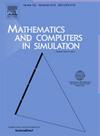动态分析和FPGA实现的二维分数正弦余弦映射的图像加密使用位级排列和遗传算法
IF 4.4
2区 数学
Q1 COMPUTER SCIENCE, INTERDISCIPLINARY APPLICATIONS
引用次数: 0
摘要
介绍了一种新的二维分数阶正弦余弦(2D- fsc)超混沌映射及其在鲁棒图像加密方案中的应用。通过包括分岔图、李雅普诺夫指数、蝴蝶效应、香农熵和相空间可视化在内的综合动力学分析,证明了该图与常规一维混沌系统相比具有优越的混沌特性。提出的加密框架采用三阶段扩散-置换-混淆架构,并通过两个关键创新得到增强:(1)优化扩散和混淆过程的遗传算法以最大化熵(7.998 ± 0.002)和最小化相关系数(|cc| <;(2)一种新的基于混沌的像素融合技术,实现高效的位级排列。在Cyclone IV FPGA(6057个逻辑元件,34.29 MHz最大频率)上的硬件实现验证了混沌映射的实际可行性。安全分析证实抵抗暴力破解(密钥空间>;2750),统计(χ²<;184.2)、差分(NPCR 99.61 ± 0.04 %,UACI 33.46 ± 0.09 %)和噪声/剪切攻击。该算法在0.32 秒内处理256x 256张图像,比可比方案快28-42 %,同时在灰度,彩色和边缘情况图像中保持一致的性能。这些进步为需要高安全性和计算效率的应用中基于混沌的密码系统建立了新的基准。本文章由计算机程序翻译,如有差异,请以英文原文为准。
Dynamic analysis and FPGA implementation of a 2D fractional sine-cosine map for image encryption using bit-level permutation and genetic algorithm
This paper introduces a novel 2D fractional sine-cosine (2D-FSC) hyperchaotic map and its application in a robust image encryption scheme. Through comprehensive dynamic analysis including bifurcation diagrams, Lyapunov exponents, butterfly effect, Shannon entropy, and phase space visualization, it is demonstrated the map's superior chaotic characteristics compared to conventional 1D chaotic systems. The proposed encryption framework employs a three-stage diffusion-permutation-confusion architecture enhanced by two key innovations: (1) a genetic algorithm optimizing diffusion and confusion processes to maximize entropy (7.998 ± 0.002) and minimize correlation coefficients (|cc| < 0.004) of the encrypted image, and (2) a novel chaos-based pixel fusion technique for efficient bit-level permutation. Hardware implementation on a Cyclone IV FPGA (6057 logic elements, 34.29 MHz max frequency) validates the practical feasibility of the chaotic map. Security analysis confirms resistance against brute-force (key space > 2750), statistical (χ² < 184.2), differential (NPCR 99.61 ± 0.04 %, UACI 33.46 ± 0.09 %), and noise/clipping attacks. The algorithm processes 256× 256 images in 0.32 s which is 28–42 % faster than comparable schemes, while maintaining consistent performance across grayscale, color, and edge-case images. These advancements establish a new benchmark for chaos-based cryptosystems in applications requiring both high security and computational efficiency.
求助全文
通过发布文献求助,成功后即可免费获取论文全文。
去求助
来源期刊

Mathematics and Computers in Simulation
数学-计算机:跨学科应用
CiteScore
8.90
自引率
4.30%
发文量
335
审稿时长
54 days
期刊介绍:
The aim of the journal is to provide an international forum for the dissemination of up-to-date information in the fields of the mathematics and computers, in particular (but not exclusively) as they apply to the dynamics of systems, their simulation and scientific computation in general. Published material ranges from short, concise research papers to more general tutorial articles.
Mathematics and Computers in Simulation, published monthly, is the official organ of IMACS, the International Association for Mathematics and Computers in Simulation (Formerly AICA). This Association, founded in 1955 and legally incorporated in 1956 is a member of FIACC (the Five International Associations Coordinating Committee), together with IFIP, IFAV, IFORS and IMEKO.
Topics covered by the journal include mathematical tools in:
•The foundations of systems modelling
•Numerical analysis and the development of algorithms for simulation
They also include considerations about computer hardware for simulation and about special software and compilers.
The journal also publishes articles concerned with specific applications of modelling and simulation in science and engineering, with relevant applied mathematics, the general philosophy of systems simulation, and their impact on disciplinary and interdisciplinary research.
The journal includes a Book Review section -- and a "News on IMACS" section that contains a Calendar of future Conferences/Events and other information about the Association.
 求助内容:
求助内容: 应助结果提醒方式:
应助结果提醒方式:


